
It’s no secret that doing outdoor sports is going to leave you soaking in sweat, especially your feet. Pickleball is not an exception, and even indoor pickleball players will agree. The quick, lateral, and constant movements in pickleball will wet your feet and even cause blisters.
So, what kind of athletic socks can you wear? There are several types of pickleball socks you can buy for yourself. You can refer to this guide to help you find the right pair of socks for your feet.
We’ll go through different cut sizes, different features, and what to expect when buying athletic socks.
Types of Pickleball Socks
There are four main types of pickleball socks. This criteria mainly refers to the sock’s height or length, from low-cut or foot socks all the way to crew socks.
-
Low-Cut or Foot Socks
Low-cut or foot socks are ideal for avoiding annoying tan lines. They’re easy to put on, which is great for the elderly, and they’re easy to keep because they’re so small.

Foot socks are also among the most commonly used socks in the world, so chances are you already have a lot of these lying around in your closet. After all, these socks look best with sneakers or other kinds of casual shoes.
What Low-Cut Socks or Foot Socks Are Great At:
- Ventilation around your ankles and calves
- Ease of use when putting on and taking off
- Aesthetically the most pleasing variety and arguably the most common one used by pickleball players
- Avoiding bad tan lines on your legs
What Low-Cut Socks or Foot Socks Are Bad For:
- Almost no ankle support
- No ankle protection, so players are prone to blisters from their shoes around the ankles—typically the back of the foot

-
Ankle Socks
Ankle socks are a great compromise between foot socks and “dad socks”. They provide decent coverage for your ankles while still allowing lots of movement. These kinds of socks aren’t commonly used in sports, but they’re cheaper than quarter-length socks and crew socks that are much longer.

What Ankle Socks Are Great At:
- Ankle support. The band at the top of the sock will compress your ankle for better blood flow.
- Good coverage for protecting your ankles from abrasions or blisters from your shoes.
- Like foot socks, ankle socks are still easier to put on and take off than other socks. You can usually put these on in one fluid motion.
What Ankle Socks Are Bad For:
- In my opinion, they are the least attractive options. But you can find a pair that complements the color of your shoes and your outfit to make it work.
- Not enough coverage to protect the rest of your leg from abrasions when you trip or fall.
-
Quarter-Length Socks
Quarter-length is the more technical term, but you’ll probably recognize them as “dad socks” since they’re the kind of socks worn by dads with tennis shoes and cargo shorts.
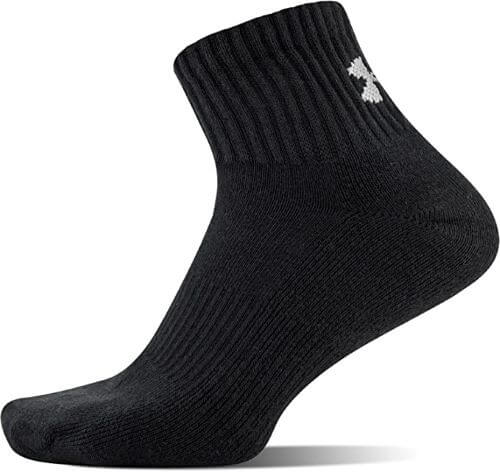
These socks are the ones that go above the ankle and land just before the shin. You’ll find they are the most common types of socks worn by blue-collar workers because they provide lots of support.
What Quarter-Length Socks Are Great At:
- Great support for your entire foot—ankles and all. Longer socks like this make your feet feel much more secure than ankle socks or foot socks.
- Better for moisture-wicking fabrics, because there is more of the sock that’s actually exposed to the air.
- Good for compressing your feet and ankles for improved blood flow.
What Quarter-Length Socks Are Bad For:
- Can feel hotter than other socks, which increases sweat even if it is better at wicking moisture.
- Because they look like “dad socks”, they aren’t the most stylish socks you can wear either.
-
Crew Socks
Crew socks are the kind of socks that proper athletes wear. They’re much longer and will reach all the way to your upper calf, just a couple of inches before your knees. These are the best for moisture-wicking socks for making your feet feel extremely secure.
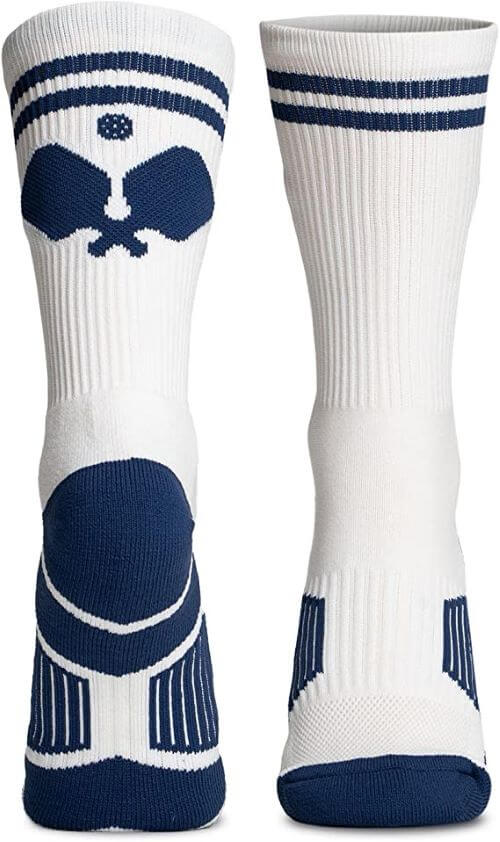
What Crew Socks Are Great At:
- Protection from falls and other accidents that can bruise or impact your leg.
- Great for keeping warm in colder weather and for playing outside.
- The best at keeping your legs active with lots of blood flow during long matches and long days.
- Looking athletic and aesthetic for playing sports, much better compared to quarter-length, dad socks.
What Crew Socks Are Bad For:
- Easy to feel hot in.
- If you aren’t playing, you can’t wear these for too long casually. Your legs will start feeling like they aren’t getting enough blood.
- Depending on the thickness of your calves, you’ll have to be particular about finding the right size for your legs.
- Takes a much longer time to put on.

How to Find Your Type of Pickleball Socks
Hold up! Knowing the different types of pickleball socks isn’t enough. There’s a lot more to consider before finding and buying the kind of pickleball socks that are for you.
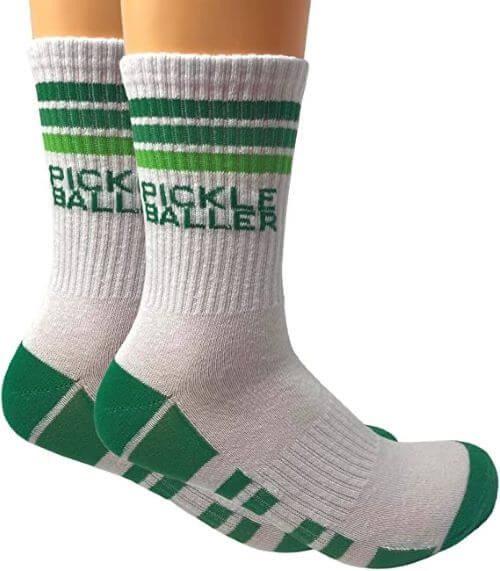
In this part of the article, we’ll go through a short buyer’s guide on how to find your type of pickleball socks. After that, I’ll list the top features to look for when shopping around for athletic socks. And to close, I’ll also talk about the different kinds of sock materials so you won’t get lost.
Let’s keep going!
Comfort
If you aren’t comfortable with putting on crew socks, don’t force it! There are a ton of professional athletes that stick with foot socks or ankle socks and still dominate in their field.
Comfort is a subjective thing, and not everyone will like having their entire foot and leg cramped inside a sock. In fact, if you’ve been blessed with long-leg hair, you might find them especially uncomfortable.
Breathability
Have you ever tried taking off a sock after a long game or after doing something sweaty? The odor and feeling of constant moisture around your feet is a recipe for divorce. Sock breathability largely depends on the material and technology of your socks. We’ll talk more about that below.
Cost
You don’t need to spend a hundred bucks for several pairs of socks. There are a lot of durable, comfortable, and bang-for-the-buck socks out there for sale. Unless you’re aiming to become a pro or you’re using pickleball as an outlet for all your energy and frustration, there’s no need to invest so much money on just some socks.
Style
I’ve always been the self-conscious type, and playing sports while wearing something I’m not comfortable with is always reflected in my performance. After all, we all have our preferences and opinions on what makes us look good and what doesn’t.
If what you’re wearing makes you feel good and comfortable, you will play better. Instead of constantly worrying about how you look with dad socks on, spend a couple of dollars on something else. You’re not just paying for a pair of socks—you’re paying for confidence and ease of mind.
Key Features of Athletic Socks
Last, but not least, key features of athletic socks should be one of your biggest considerations when buying pickleball socks. These are all features that are meant to solve the problems of athletes. So, pickleball players like yourself should look for socks that don’t stink up your feet, make you feel wet all the time, or cause you pain while playing.
Top Features of Pickleball Socks
Athletic socks have come a long way and it’s mainly because of consumers who demanded a solution to their problems. Here are what the right pair of pickleball socks can do for you.
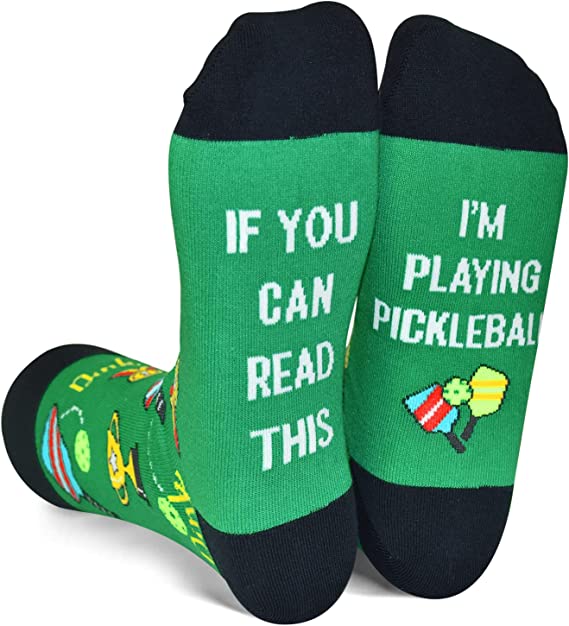
Compression
The right socks will enhance your endurance, recovery, and performance. Compressing your feet with a sock promotes better blood flow, which improves oxygen delivery to your muscles. These socks are also better for your recovery because they reduce swelling, soreness, and inflammation in your feet.
Graduated compression is when the pressure is stronger at the ankle and gradually lessens as the sock goes up to the calf. This is better for blood flow compared to a compression sock that evenly compresses the entire ankle to calf area.
Moisture Wicking
The most common feature when it comes to athletic socks is moisture-wicking fabric. This kind of fabric is designed to move moisture from inside the sock to the outer layer, making your sweat evaporate faster.
The nature of this material makes it more breathable and cooler because they remove moisture and sweat. This, in turn, hampers bacteria growth and prevents them from stinking up your feet.
Cushioned Socks
Some pickleball players need cushioned socks that are thicker in certain areas, like the ankle and soles of their feet. This is to help with pain in those areas. Cushioned socks are much more comfortable, though they run the risk of feeling hotter.
Using your shoes to play sports is very different from using them casually. First-time players might notice that their shoes don’t “wrap” around their feet securely. This is where cushioned socks come into play. Because they’re much thicker, cushioned socks are also used to “fill in” shoes that are slightly too big for the pickleball player.
Anti-Blister
Players who have sensitive skin are prone to blisters, even if they are using pricey socks. Blisters are generally caused by friction when your skin gets frequently rubbed against a foreign object. In this case, from the seams of the sock itself. Socks that are anti-blister are seamless, so the rubbing and friction against the skin are as minimal as possible.
If you can’t find anti-blister socks specifically, simply ensuring that your sock fits snugly on your feet is enough. Large socks that have room to move will rub and cause blisters. Socks that are too tight will also cut through your skin after extensive use.
Types of Material for Pickleball Socks
The kind of material your pickleball socks are made of plays a huge part in their effectiveness. Whether it’s to cushion, remove moisture, or compress your feet for better blood flow, the sock material is crucial.
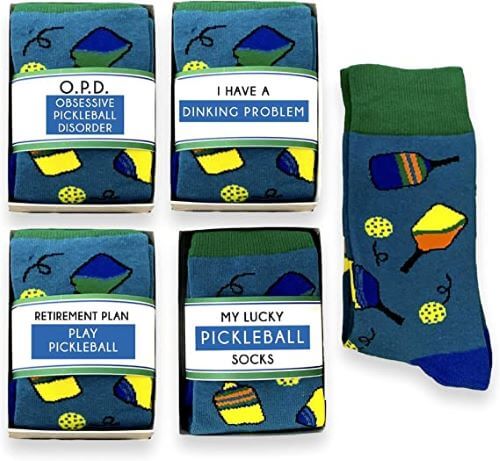
However, outside of cotton, all of the materials listed below are usually combined together in different amounts. How these materials are combined and their quantity determines their effectiveness and their use case a lot.
Cotton
Cotton is the most common material for socks. In fact, even in socks that are made by combining other materials, cotton is usually 70 to 85 percent of the material.
Avoid buying pure cotton socks as these have almost no moisture-wicking capabilities. While they are slightly breathable, they aren’t going to compress or protect you from blisters that well.
Polyester
Polyester is known for its moisture-wicking properties that effectively pull sweat away from the skin. This allows for better breathability and air circulation to help regulate temperature and prevent excessive sweat buildup. It also dries relatively quickly, keeping you comfortable during physical activities.
Nylon
Nylon is known for its high durability and strength. It is a lightweight, stretchy material that is resistant to abrasion and can withstand rigorous playing. Its excellent moisture-wicking properties draw sweat away from the skin and allow it to evaporate quickly, making it suitable for pickleball play.
Spandex
Also known as elastane, spandex offers exceptional stretch and flexibility that allows you the freedom to move around as you wish without worrying about the garment losing its shape and fit, no matter how many times you wear and wash it. It is excellent at providing compression to aid in muscle support, improved circulation, and enhanced performance.
In terms of comfort, spandex offers a snug and flexible fit. It is often blended with other materials, such as nylon or polyester, to provide stretch and improved fit in garments like socks.